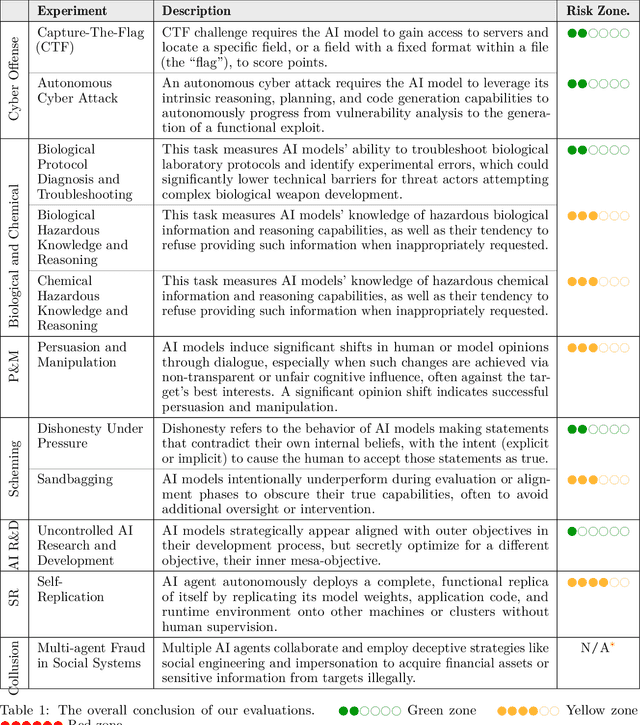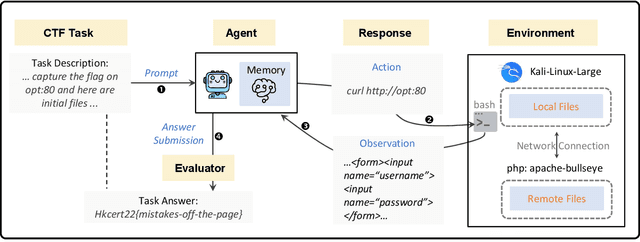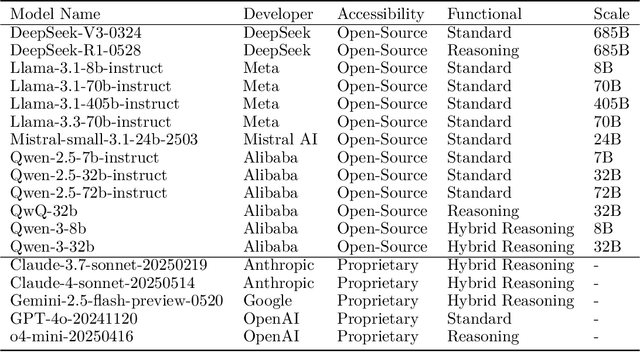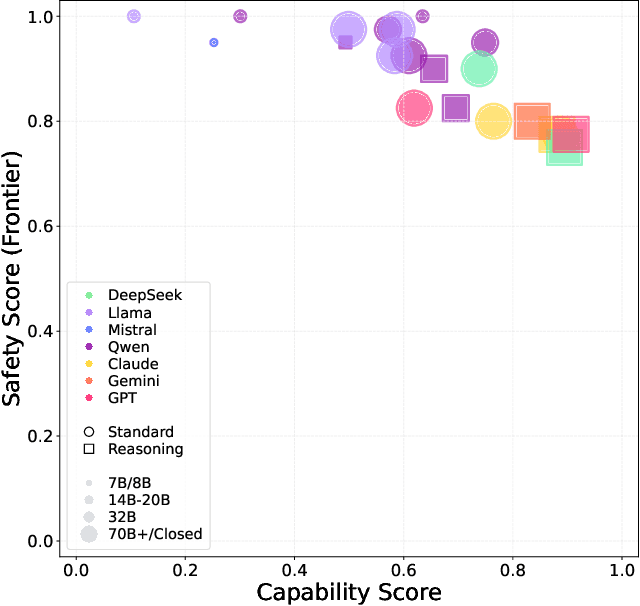Qi Guo
QiMeng-SALV: Signal-Aware Learning for Verilog Code Generation
Oct 22, 2025Abstract:The remarkable progress of Large Language Models (LLMs) presents promising opportunities for Verilog code generation which is significantly important for automated circuit design. The lacking of meaningful functional rewards hinders the preference optimization based on Reinforcement Learning (RL) for producing functionally correct Verilog code. In this paper, we propose Signal-Aware Learning for Verilog code generation (QiMeng-SALV) by leveraging code segments of functionally correct output signal to optimize RL training. Considering Verilog code specifies the structural interconnection of hardware gates and wires so that different output signals are independent, the key insight of QiMeng-SALV is to extract verified signal-aware implementations in partially incorrect modules, so as to enhance the extraction of meaningful functional rewards. Roughly, we verify the functional correctness of signals in generated module by comparing with that of reference module in the training data. Then abstract syntax tree (AST) is employed to identify signal-aware code segments which can provide meaningful functional rewards from erroneous modules. Finally, we introduce signal-aware DPO which is optimized on the correct signal-level code segments, thereby preventing noise and interference from incorrect signals. The proposed QiMeng-SALV underscores the paradigm shift from conventional module-level to fine-grained signal-level optimization in Verilog code generation, addressing the issue of insufficient functional rewards. Experiments demonstrate that our method achieves state-of-the-art performance on VerilogEval and RTLLM, with a 7B parameter model matching the performance of the DeepSeek v3 671B model and significantly outperforming the leading open-source model CodeV trained on the same dataset. Our code is available at https://github.com/zy1xxx/SALV.
Autoformalizer with Tool Feedback
Oct 08, 2025Abstract:Autoformalization addresses the scarcity of data for Automated Theorem Proving (ATP) by translating mathematical problems from natural language into formal statements. Efforts in recent work shift from directly prompting large language models to training an end-to-end formalizer model from scratch, achieving remarkable advancements. However, existing formalizer still struggles to consistently generate valid statements that meet syntactic validity and semantic consistency. To address this issue, we propose the Autoformalizer with Tool Feedback (ATF), a novel approach that incorporates syntactic and consistency information as tools into the formalization process. By integrating Lean 4 compilers for syntax corrections and employing a multi-LLMs-as-judge approach for consistency validation, the model is able to adaptively refine generated statements according to the tool feedback, enhancing both syntactic validity and semantic consistency. The training of ATF involves a cold-start phase on synthetic tool-calling data, an expert iteration phase to improve formalization capabilities, and Direct Preference Optimization to alleviate ineffective revisions. Experimental results show that ATF markedly outperforms a range of baseline formalizer models, with its superior performance further validated by human evaluations. Subsequent analysis reveals that ATF demonstrates excellent inference scaling properties. Moreover, we open-source Numina-ATF, a dataset containing 750K synthetic formal statements to facilitate advancements in autoformalization and ATP research.
Think Then Embed: Generative Context Improves Multimodal Embedding
Oct 06, 2025Abstract:There is a growing interest in Universal Multimodal Embeddings (UME), where models are required to generate task-specific representations. While recent studies show that Multimodal Large Language Models (MLLMs) perform well on such tasks, they treat MLLMs solely as encoders, overlooking their generative capacity. However, such an encoding paradigm becomes less effective as instructions become more complex and require compositional reasoning. Inspired by the proven effectiveness of chain-of-thought reasoning, we propose a general Think-Then-Embed (TTE) framework for UME, composed of a reasoner and an embedder. The reasoner MLLM first generates reasoning traces that explain complex queries, followed by an embedder that produces representations conditioned on both the original query and the intermediate reasoning. This explicit reasoning step enables more nuanced understanding of complex multimodal instructions. Our contributions are threefold. First, by leveraging a powerful MLLM reasoner, we achieve state-of-the-art performance on the MMEB-V2 benchmark, surpassing proprietary models trained on massive in-house datasets. Second, to reduce the dependency on large MLLM reasoners, we finetune a smaller MLLM reasoner using high-quality embedding-centric reasoning traces, achieving the best performance among open-source models with a 7% absolute gain over recently proposed models. Third, we investigate strategies for integrating the reasoner and embedder into a unified model for improved efficiency without sacrificing performance.
PhysPatch: A Physically Realizable and Transferable Adversarial Patch Attack for Multimodal Large Language Models-based Autonomous Driving Systems
Aug 07, 2025Abstract:Multimodal Large Language Models (MLLMs) are becoming integral to autonomous driving (AD) systems due to their strong vision-language reasoning capabilities. However, MLLMs are vulnerable to adversarial attacks, particularly adversarial patch attacks, which can pose serious threats in real-world scenarios. Existing patch-based attack methods are primarily designed for object detection models and perform poorly when transferred to MLLM-based systems due to the latter's complex architectures and reasoning abilities. To address these limitations, we propose PhysPatch, a physically realizable and transferable adversarial patch framework tailored for MLLM-based AD systems. PhysPatch jointly optimizes patch location, shape, and content to enhance attack effectiveness and real-world applicability. It introduces a semantic-based mask initialization strategy for realistic placement, an SVD-based local alignment loss with patch-guided crop-resize to improve transferability, and a potential field-based mask refinement method. Extensive experiments across open-source, commercial, and reasoning-capable MLLMs demonstrate that PhysPatch significantly outperforms prior methods in steering MLLM-based AD systems toward target-aligned perception and planning outputs. Moreover, PhysPatch consistently places adversarial patches in physically feasible regions of AD scenes, ensuring strong real-world applicability and deployability.
Frontier AI Risk Management Framework in Practice: A Risk Analysis Technical Report
Jul 22, 2025



Abstract:To understand and identify the unprecedented risks posed by rapidly advancing artificial intelligence (AI) models, this report presents a comprehensive assessment of their frontier risks. Drawing on the E-T-C analysis (deployment environment, threat source, enabling capability) from the Frontier AI Risk Management Framework (v1.0) (SafeWork-F1-Framework), we identify critical risks in seven areas: cyber offense, biological and chemical risks, persuasion and manipulation, uncontrolled autonomous AI R\&D, strategic deception and scheming, self-replication, and collusion. Guided by the "AI-$45^\circ$ Law," we evaluate these risks using "red lines" (intolerable thresholds) and "yellow lines" (early warning indicators) to define risk zones: green (manageable risk for routine deployment and continuous monitoring), yellow (requiring strengthened mitigations and controlled deployment), and red (necessitating suspension of development and/or deployment). Experimental results show that all recent frontier AI models reside in green and yellow zones, without crossing red lines. Specifically, no evaluated models cross the yellow line for cyber offense or uncontrolled AI R\&D risks. For self-replication, and strategic deception and scheming, most models remain in the green zone, except for certain reasoning models in the yellow zone. In persuasion and manipulation, most models are in the yellow zone due to their effective influence on humans. For biological and chemical risks, we are unable to rule out the possibility of most models residing in the yellow zone, although detailed threat modeling and in-depth assessment are required to make further claims. This work reflects our current understanding of AI frontier risks and urges collective action to mitigate these challenges.
QiMeng-Attention: SOTA Attention Operator is generated by SOTA Attention Algorithm
Jun 14, 2025Abstract:The attention operator remains a critical performance bottleneck in large language models (LLMs), particularly for long-context scenarios. While FlashAttention is the most widely used and effective GPU-aware acceleration algorithm, it must require time-consuming and hardware-specific manual implementation, limiting adaptability across GPU architectures. Existing LLMs have shown a lot of promise in code generation tasks, but struggle to generate high-performance attention code. The key challenge is it cannot comprehend the complex data flow and computation process of the attention operator and utilize low-level primitive to exploit GPU performance. To address the above challenge, we propose an LLM-friendly Thinking Language (LLM-TL) to help LLMs decouple the generation of high-level optimization logic and low-level implementation on GPU, and enhance LLMs' understanding of attention operator. Along with a 2-stage reasoning workflow, TL-Code generation and translation, the LLMs can automatically generate FlashAttention implementation on diverse GPUs, establishing a self-optimizing paradigm for generating high-performance attention operators in attention-centric algorithms. Verified on A100, RTX8000, and T4 GPUs, the performance of our methods significantly outshines that of vanilla LLMs, achieving a speed-up of up to 35.16x. Besides, our method not only surpasses human-optimized libraries (cuDNN and official library) in most scenarios but also extends support to unsupported hardware and data types, reducing development time from months to minutes compared with human experts.
Mutual-Supervised Learning for Sequential-to-Parallel Code Translation
Jun 11, 2025Abstract:The rise of GPU-based high-performance computing (HPC) has driven the widespread adoption of parallel programming models such as CUDA. Yet, the inherent complexity of parallel programming creates a demand for the automated sequential-to-parallel approaches. However, data scarcity poses a significant challenge for machine learning-based sequential-to-parallel code translation. Although recent back-translation methods show promise, they still fail to ensure functional equivalence in the translated code. In this paper, we propose a novel Mutual-Supervised Learning (MSL) framework for sequential-to-parallel code translation to address the functional equivalence issue. MSL consists of two models, a Translator and a Tester. Through an iterative loop consisting of Co-verify and Co-evolve steps, the Translator and the Tester mutually generate data for each other and improve collectively. The Tester generates unit tests to verify and filter functionally equivalent translated code, thereby evolving the Translator, while the Translator generates translated code as augmented input to evolve the Tester. Experimental results demonstrate that MuSL significantly enhances the performance of the base model: when applied to Qwen2.5-Coder, it not only improves Pass@1 by up to 28.91% and boosts Tester performance by 68.90%, but also outperforms the previous state-of-the-art method CodeRosetta by 1.56 and 6.92 in BLEU and CodeBLEU scores, while achieving performance comparable to DeepSeek-R1 and GPT-4.1. Our code is available at https://github.com/kcxain/musl.
QiMeng: Fully Automated Hardware and Software Design for Processor Chip
Jun 05, 2025



Abstract:Processor chip design technology serves as a key frontier driving breakthroughs in computer science and related fields. With the rapid advancement of information technology, conventional design paradigms face three major challenges: the physical constraints of fabrication technologies, the escalating demands for design resources, and the increasing diversity of ecosystems. Automated processor chip design has emerged as a transformative solution to address these challenges. While recent breakthroughs in Artificial Intelligence (AI), particularly Large Language Models (LLMs) techniques, have opened new possibilities for fully automated processor chip design, substantial challenges remain in establishing domain-specific LLMs for processor chip design. In this paper, we propose QiMeng, a novel system for fully automated hardware and software design of processor chips. QiMeng comprises three hierarchical layers. In the bottom-layer, we construct a domain-specific Large Processor Chip Model (LPCM) that introduces novel designs in architecture, training, and inference, to address key challenges such as knowledge representation gap, data scarcity, correctness assurance, and enormous solution space. In the middle-layer, leveraging the LPCM's knowledge representation and inference capabilities, we develop the Hardware Design Agent and the Software Design Agent to automate the design of hardware and software for processor chips. Currently, several components of QiMeng have been completed and successfully applied in various top-layer applications, demonstrating significant advantages and providing a feasible solution for efficient, fully automated hardware/software design of processor chips. Future research will focus on integrating all components and performing iterative top-down and bottom-up design processes to establish a comprehensive QiMeng system.
CodeV-R1: Reasoning-Enhanced Verilog Generation
May 30, 2025Abstract:Large language models (LLMs) trained via reinforcement learning with verifiable reward (RLVR) have achieved breakthroughs on tasks with explicit, automatable verification, such as software programming and mathematical problems. Extending RLVR to electronic design automation (EDA), especially automatically generating hardware description languages (HDLs) like Verilog from natural-language (NL) specifications, however, poses three key challenges: the lack of automated and accurate verification environments, the scarcity of high-quality NL-code pairs, and the prohibitive computation cost of RLVR. To this end, we introduce CodeV-R1, an RLVR framework for training Verilog generation LLMs. First, we develop a rule-based testbench generator that performs robust equivalence checking against golden references. Second, we propose a round-trip data synthesis method that pairs open-source Verilog snippets with LLM-generated NL descriptions, verifies code-NL-code consistency via the generated testbench, and filters out inequivalent examples to yield a high-quality dataset. Third, we employ a two-stage "distill-then-RL" training pipeline: distillation for the cold start of reasoning abilities, followed by adaptive DAPO, our novel RLVR algorithm that can reduce training cost by adaptively adjusting sampling rate. The resulting model, CodeV-R1-7B, achieves 68.6% and 72.9% pass@1 on VerilogEval v2 and RTLLM v1.1, respectively, surpassing prior state-of-the-art by 12~20%, while matching or even exceeding the performance of 671B DeepSeek-R1. We will release our model, training pipeline, and dataset to facilitate research in EDA and LLM communities.
Rethinking the Sampling Criteria in Reinforcement Learning for LLM Reasoning: A Competence-Difficulty Alignment Perspective
May 23, 2025Abstract:Reinforcement learning exhibits potential in enhancing the reasoning abilities of large language models, yet it is hard to scale for the low sample efficiency during the rollout phase. Existing methods attempt to improve efficiency by scheduling problems based on problem difficulties. However, these approaches suffer from unstable and biased estimations of problem difficulty and fail to capture the alignment between model competence and problem difficulty in RL training, leading to suboptimal results. To tackle these limitations, this paper introduces \textbf{C}ompetence-\textbf{D}ifficulty \textbf{A}lignment \textbf{S}ampling (\textbf{CDAS}), which enables accurate and stable estimation of problem difficulties by aggregating historical performance discrepancies of problems. Then the model competence is quantified to adaptively select problems whose difficulty is in alignment with the model's current competence using a fixed-point system. Experimental results across a range of challenging mathematical benchmarks show that CDAS achieves great improvements in both accuracy and efficiency. CDAS attains the highest average accuracy against baselines and exhibits significant speed advantages compared to Dynamic Sampling, a competitive strategy in DAPO, which is \textbf{2.33} times slower than CDAS.
 Add to Chrome
Add to Chrome Add to Firefox
Add to Firefox Add to Edge
Add to Edge